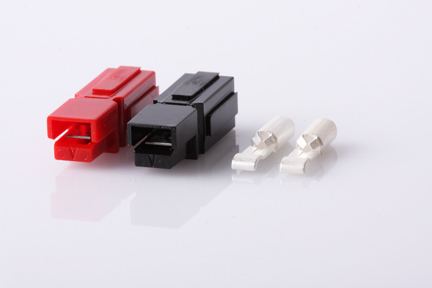 | ||
The Anderson Powerpole is a family of electrical connectors by Anderson Power Products (APP), although plug compatible connectors are now available from alternate sources. Specific variants of this series of connectors have become de facto standards for conveying "higher power" direct current (DC) electrical power, although these standards are inconsistent and sometimes ignored.
Contents
Overview
Powerpole connectors are physically and electrically hermaphroditic, thus avoiding the need to worry about which end is the plug and which the socket, or which end has the correct polarity. This is in contrast to the physically but not electrically hermaphroditic two-wire trailer plug.
Powerpole connectors are available with current ratings up to 180 amperes. The size most commonly used is the 15 / 30 / 45 ampere variety. These sizes all use the same plastic housing in multiple colors, differing only in the metal contact inserted into the housing (selected based on the ampacity and wire size). Power poles can be attached side to side and also stacked on top of each other to make, for example, four connections with one plug motion.
Larger Powerpole connectors (the SB/Multipole series) with two or three contacts in one molded housing are commonly used in various industrial settings, including as a battery connection for some uninterruptible power supplies (UPS), removable vehicle winches, many electric forklifts, and other electric vehicles.
Competitors
Some of Anderson's earlier patents have expired, thus other manufacturers have released plug-compatible connectors, such as "AMP Power Series" by Tyco / TE Connectivity, Sermos, Lightspeed.
Patents
The Powerpole connector was designed and patented by "Albert & J M Anderson Mfg Comp", then more recently as "Anderson Power Products".
Color
For the larger multipole design, which is available in up to 700 A sizes, each color is physically keyed so as to mate only with a like colored connector, and Anderson published a list of recommended voltage for each color:
Amateur radio
The Powerpole connector has been adopted by some segments of the Amateur Radio (Ham Radio) community as their standard 12-volt DC power connector for everything from radios to accessories. Two notable groups are Amateur Radio Emergency Service (ARES) and Radio Amateur Civil Emergency Service (RACES). It is more expensive than the older de facto standards of the two-wire trailer plug and the Molex connector, but provides a more reliable electrical connection (both mechanically and electrically), and is easier to adapt to a wider range of wire gauges.
Amateur radio equipment is based on 12-volt DC automotive voltage, which is also called 13.8-volt DC. A lead–acid battery with six-cells used as an automotive battery voltage will vary depending on various electrical loads in a vehicle. Without loads the battery will float at 11.7–12.8 volts, and while charging from an alternator the voltage will increase to 13.8–14.4 volts DC.
For use in amateur radio, the community has adopted a standard polarity for assembling pairs of Powerpole connectors. The standard is red positive and black negative. When viewed from the contact side, a mnemonic for remembering the arrangement for the positive connector is: "red right — tongue top".
Model railways
In model railways, the NTRAK Modular Railroading Society adopted the PowerPole PP30 as a recommend practice in 2005. and as a standard in 2011. The use of the older Cinch-Jones connector has been deprecated, but is still permitted on legacy modules. However, the owner of a module with Cinch-Jones plugs is now required to provide adapter cables to the newer standard. North Raleigh Model Railroad Club (NRMRC) also uses Anderson Powerpole connectors. Free-mo modular standard adopted Powerpole as the new connector standard as of 1 July 2015, with a one-year transition period to convert existing Jones connectors.
Robotics
The connectors are used by some robot builders, including the FIRST Robotics Competition and R2-D2 Builders Club.
Radio control
The connectors are used by radio control (R/C) hobbyist clubs.
Data centers
Buildings such as data centers are starting to be designed for 380 V DC power distribution, as a way of improving electrical efficiency. DC power distribution has resulted in the need to standardize a Low Voltage (LV) connector with an integral ground conductor, which is safe for use by untrained personnel. The tendency of DC connectors to spark when disconnected from an inductive load requires the connector's insulating housing to contain the plasma arc, in addition to normal requirements such as preventing accidental finger contact. Examples of such connectors are the Anderson Powerpole Pak connectors and the SDG (Saf-D-Grid) connector, designed with the form factor of an IEC C15 connector.
